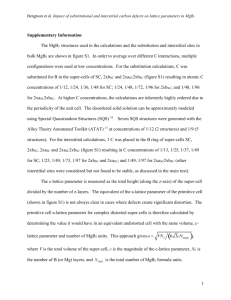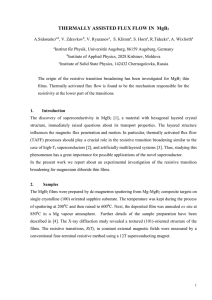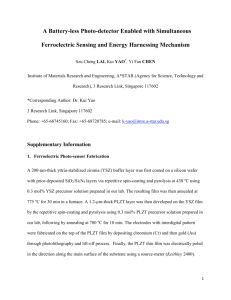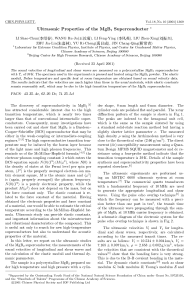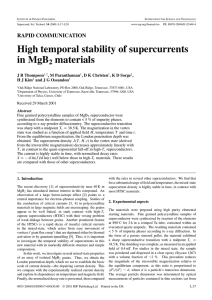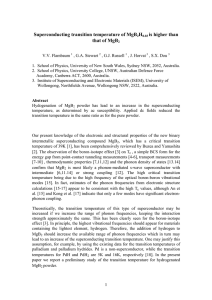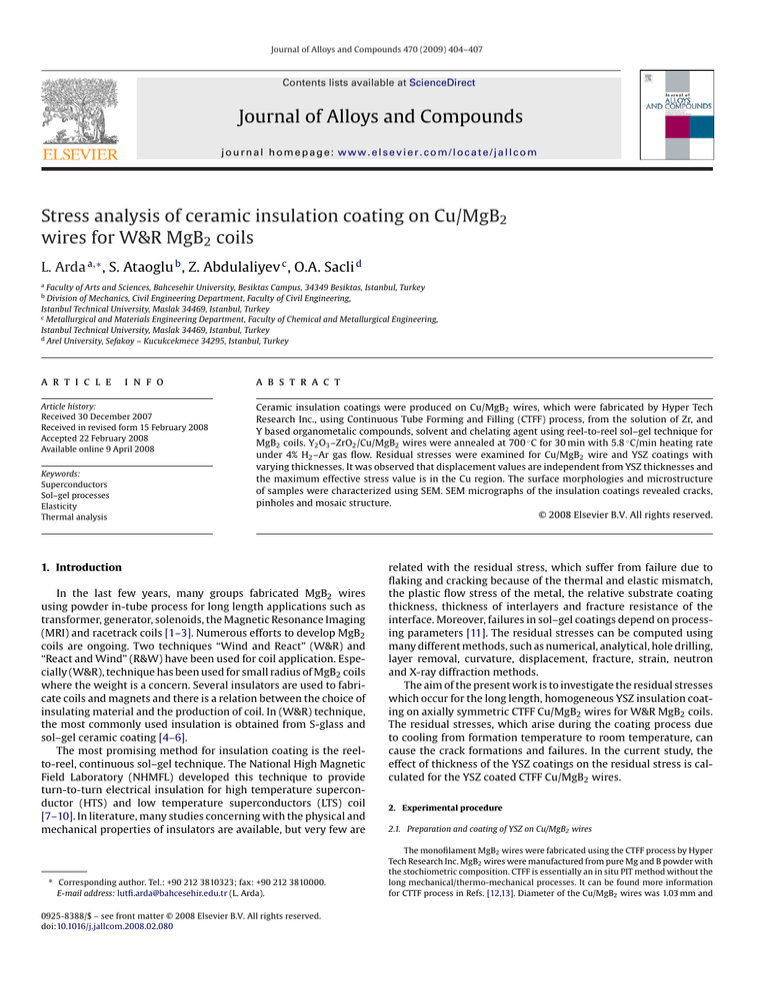
Journal of Alloys and Compounds 470 (2009) 404–407
Contents lists available at ScienceDirect
Journal of Alloys and Compounds
journal homepage: www.elsevier.com/locate/jallcom
Stress analysis of ceramic insulation coating on Cu/MgB2
wires for W&R MgB2 coils
L. Arda a,∗ , S. Ataoglu b , Z. Abdulaliyev c , O.A. Sacli d
a
Faculty of Arts and Sciences, Bahcesehir University, Besiktas Campus, 34349 Besiktas, Istanbul, Turkey
Division of Mechanics, Civil Engineering Department, Faculty of Civil Engineering,
Istanbul Technical University, Maslak 34469, Istanbul, Turkey
c
Metallurgical and Materials Engineering Department, Faculty of Chemical and Metallurgical Engineering,
Istanbul Technical University, Maslak 34469, Istanbul, Turkey
d
Arel University, Sefakoy – Kucukcekmece 34295, Istanbul, Turkey
b
a r t i c l e
i n f o
Article history:
Received 30 December 2007
Received in revised form 15 February 2008
Accepted 22 February 2008
Available online 9 April 2008
Keywords:
Superconductors
Sol–gel processes
Elasticity
Thermal analysis
a b s t r a c t
Ceramic insulation coatings were produced on Cu/MgB2 wires, which were fabricated by Hyper Tech
Research Inc., using Continuous Tube Forming and Filling (CTFF) process, from the solution of Zr, and
Y based organometalic compounds, solvent and chelating agent using reel-to-reel sol–gel technique for
MgB2 coils. Y2 O3 –ZrO2 /Cu/MgB2 wires were annealed at 700 ◦ C for 30 min with 5.8 ◦ C/min heating rate
under 4% H2 –Ar gas flow. Residual stresses were examined for Cu/MgB2 wire and YSZ coatings with
varying thicknesses. It was observed that displacement values are independent from YSZ thicknesses and
the maximum effective stress value is in the Cu region. The surface morphologies and microstructure
of samples were characterized using SEM. SEM micrographs of the insulation coatings revealed cracks,
pinholes and mosaic structure.
© 2008 Elsevier B.V. All rights reserved.
1. Introduction
In the last few years, many groups fabricated MgB2 wires
using powder in-tube process for long length applications such as
transformer, generator, solenoids, the Magnetic Resonance Imaging
(MRI) and racetrack coils [1–3]. Numerous efforts to develop MgB2
coils are ongoing. Two techniques “Wind and React” (W&R) and
“React and Wind” (R&W) have been used for coil application. Especially (W&R), technique has been used for small radius of MgB2 coils
where the weight is a concern. Several insulators are used to fabricate coils and magnets and there is a relation between the choice of
insulating material and the production of coil. In (W&R) technique,
the most commonly used insulation is obtained from S-glass and
sol–gel ceramic coating [4–6].
The most promising method for insulation coating is the reelto-reel, continuous sol–gel technique. The National High Magnetic
Field Laboratory (NHMFL) developed this technique to provide
turn-to-turn electrical insulation for high temperature superconductor (HTS) and low temperature superconductors (LTS) coil
[7–10]. In literature, many studies concerning with the physical and
mechanical properties of insulators are available, but very few are
∗ Corresponding author. Tel.: +90 212 3810323; fax: +90 212 3810000.
E-mail address: lutfi.arda@bahcesehir.edu.tr (L. Arda).
0925-8388/$ – see front matter © 2008 Elsevier B.V. All rights reserved.
doi:10.1016/j.jallcom.2008.02.080
related with the residual stress, which suffer from failure due to
flaking and cracking because of the thermal and elastic mismatch,
the plastic flow stress of the metal, the relative substrate coating
thickness, thickness of interlayers and fracture resistance of the
interface. Moreover, failures in sol–gel coatings depend on processing parameters [11]. The residual stresses can be computed using
many different methods, such as numerical, analytical, hole drilling,
layer removal, curvature, displacement, fracture, strain, neutron
and X-ray diffraction methods.
The aim of the present work is to investigate the residual stresses
which occur for the long length, homogeneous YSZ insulation coating on axially symmetric CTFF Cu/MgB2 wires for W&R MgB2 coils.
The residual stresses, which arise during the coating process due
to cooling from formation temperature to room temperature, can
cause the crack formations and failures. In the current study, the
effect of thickness of the YSZ coatings on the residual stress is calculated for the YSZ coated CTFF Cu/MgB2 wires.
2. Experimental procedure
2.1. Preparation and coating of YSZ on Cu/MgB2 wires
The monofilament MgB2 wires were fabricated using the CTFF process by Hyper
Tech Research Inc. MgB2 wires were manufactured from pure Mg and B powder with
the stochiometric composition. CTFF is essentially an in situ PIT method without the
long mechanical/thermo-mechanical processes. It can be found more information
for CTTF process in Refs. [12,13]. Diameter of the Cu/MgB2 wires was 1.03 mm and
L. Arda et al. / Journal of Alloys and Compounds 470 (2009) 404–407
405
Table 1
Properties of the Materials [14–17]
MgB2
Cu
YSZ
Index number
E (GPa)
˛ (10−6 K)
1
2
3
151
120
53
0.18
0.32
0.25
8.3
16.7
7.2
Table 2
Dimensions of the Structure as m
b
c
d
Case I
Case II
Case III
309
515
516
309
515
517
309
515
518
Fig. 1. Typical SEM micrographs of cross section area of Cu/MgB2 wire. The white
scale bar is 200 m.
the cross-sectional areas of superconducting cores were found to be 2.9 × 10−3 cm2
from SEM picture as shown in Fig. 1.
The 3 mol% Y2 O3 –ZrO2 solutions were synthesized by sol–gel process using
Yttrium acetate and Zirconium tetrabutoxide. Yttrium acetate 99.99% was dissolved
in isoproponal at room temperature by stirring for 90 min. Zr[O(CH2 )3 CH3 ]4 was
then added. Glacial acetic acid (GAA) and Acetyl acetone were used as chelating
agent in solution, and then mixed with a magnetic stirrer for 24 h at room temperature until a transparent solution was obtained just like Ref. [11]. The pH of the
solution was measured by standard pH meter. Isoproponal was used to vary viscosity
of the solutions.
YSZ film was coated on Cu/MgB2 wires with sol–gel method by using vertical three-zone furnace as seen in Fig. 2. Furnace zone temperatures were between
450 and 700 ◦ C from bottom to the top. The film thickness was controlled by the
withdrawal speed, the number of dipping and the viscidity of the solution.
Fig. 3. Sketch of axially symmetric YSZ/Cu/MgB2 wire.
Cu/MgB2 wires were insulated, and it was verified that the sol–gel insulation
coating process did not affect the superconducting properties. Surface morphology,
thickness and stochiometry of coating films were observed by using the Environmental Scanning Electron Microscope (SEM, electro scan model E-3), the Tencor
Alpha-step 200 profilemeter, and the Energy Dispersive Spectroscopy (EDS), respectively.
2.2. Residual stress analysis of axially symmetric YSZ/Cu/MgB2 wires
In this section, the residual stress is examined in axially symmetric YSZ/Cu/MgB2
wires. Material properties at room temperature, and the dimensions of the investigated sample are given in Tables 1 and 2, respectively.
Lamé’s solution [18] can be used to calculate the stress state in this cylindrical
rod which is composed of (YSZ/Cu/MgB2 ). The materials filling the regions in the
structure are indexed as shown in Fig. 3.
The related solution of the problem is obtained using continuity conditions
among the regions of structure. They are as follows:
(1) Displacement between the region in the centre, indexed by 1 and the second
region, indexed by 2
u1 = u2
Fig. 2. The continuous, reel-to-reel sol–gel coating system; (1) a three-zone-furnace,
(2) pay-off spool, (3) take-up spool, (4) two electric motor for spool, (5) furnace
controllers, (6) tapes or wire being insulated and (7) solution tank.
at r = b
(1)
and
(2) Displacement between the second region, indexed by 2 and the third region (YSZ
coating), indexed by 3
u2 = u3
at r = c
(2)
406
L. Arda et al. / Journal of Alloys and Compounds 470 (2009) 404–407
Fig. 4. Variations of stress components, r , , z .
According to Lamé’s solution, the expression of displacement is
u=
2
2
2 2
1 − 2 pi ri − po ro
1 + ri ro pi − po
r+
r ro2 − r 2
E
E
ro2 − ri2
i
(3)
where and E denote the Poisson’s ratio and modulus of elasticity, respectively.
ri and ro represent the inner and outer radii of the cylinder, and pi and po are the
uniform internal and external pressures acting on the boundaries.
If Eq. (3) is written for both of the first and second conditions given above, the
following expressions are obtained.
1 − 22 pb b2 + pc c 2
1 + 2 2 pb + pc
1 − 21
pb b + b˛1 T = −
b−
bc 2
+ b˛2 T
E1
E2
E2
c 2 − b2
c − b2
(4)
1 − 22 pb b2 + pc c 2
1 + 2 2 pb + pc
c−
b c 2
+ b˛2 T
E2
E2
c 2 − b2
c − b2
1 + 3 2 pc
pc
1 − 23
3
c +
cd 2
+ c˛3 T
=
E3
E3
d2 − c 2
d − c2
(5)
−
where ␣i (i = 1, 2 and 3) is the thermal expansion coefficient belong to the associated material and T is the difference of temperature. It should be noted that the
formulation mentioned above is valid for plane stress. Therefore, Poisson’s ratio,
modulus of elasticity and the thermal expansion coefficient should be substituted
in the formulations as /(1 − ), E/(1 − 2) and ␣/(1 + ) for plane strain solution,
respectively. The simultaneous solution of Eqs. (4) and (5) gives the radial stresses
among the regions, represented by pb and pc , that occur during the cooling process.
Radial and circumferential stress components can be calculated in the parts of the
relevant structure using Lamé’s stress formulation given below because pb and pc
are already obtained values.
r =
ri2 ro2 (po − pi ) 1
pi ri2 − po ro2
+
2
2
2
r
ro − ri
ro2 − ri2
= −
ri2 ro2 (po − pi ) 1
pi ri2 − po ro2
+
r2
ro2 − ri2
ro2 − ri2
z = (r + ) − ˛ET
(6)
(7)
(8)
where z is the stress component along the length. The obtained values are given
below for Case I, II, and III, which are 1, 2 and 3 m of YSZ thicknesses, respectively.
2.2.1. Case I
The pb and pc are obtained as −394.3 and 0.071 MPa, respectively. The displacements are obtained as −2.48 and −3.3 m where r = 309 m and r = 515 m,
respectively. Values of stress components, r , , and z , illustrated in Fig. 4, are
given for different points in Table 3.
2.2.2. Case II
The pb and pc are obtained as −394.4 and 0.14 MPa, respectively. The displacements are obtained as −2.48 and −3.3 m where r = 309 m and r = 515 m,
respectively. Values of stress components, r and , illustrated in Fig. 4, are given
for different points in Table 3.
Fig. 5. Typical SEM micrographs of the surface of sol–gel insulated Cu/MgB2 wire.
The scale bar are 20 m, and 10 m, in (a) and (b) respectively.
2.2.3. Case III
The pb and pc are obtained as −394.4 and 0.21 MPa, respectively. The displacements are obtained as −2.48 and −3.3 m where r = 309 m and r = 515 m,
respectively. Values of stress components, r and , illustrated in Fig. 4, are given
for different points in Table 3.
We also calculated for the YSZ insulating coating thickness as 10 m in order
to see the effect of the insulating coating thickness on the residual stress. It was
computed that displacement values stay nearly constant, as well, variation of stress
component values.
L. Arda et al. / Journal of Alloys and Compounds 470 (2009) 404–407
Table 3
Variation of stress components (MPa)
Points
A
B
C
D
E
Case I
Case II
Case III
−394.3
−394.4
−394.4
−838.2
−838.5
−838.9
−443.8
−444
−444.2
36.76
36.65
36.54
36.68
36.5
36.33
407
radial stress component changed sign and went to zero in the outer
surface.
The axial stress component, z , was in tension in all cases and
reached its maximum value at point C, illustrated in Fig. 4, in the
copper region, minimum value was in the outer surface. As shown
in Fig. 4 and Table 3, the critical region is copper. z and have a
discontinuity in both interlayers MgB2 to Cu and Cu to YSZ, however,
radial component has no discontinuity (Table 4).
r
Points
A
F
G
H
Case I
Case II
Case III
−394.3
−394.4
−394.4
−394.3
−394.4
−394.4
0.071
0.14
0.21
0
0
0
z
Points
A
B
C
D
E
Case I
Case II
Case III
706.53
706.50
706.50
962.30
962.18
962.05
1214.71
1214.67
1214.63
267.55
267.54
267.53
267.51
267.46
267.42
Table 4
Ratios of the stress components for interlayers
Case I
Case II
Case III
(Cu) (MgB2 ) (Cu) (YSZ) z (Cu) z (MgB2 ) z (Cu) z (YSZ) 2.126
2.126
2.127
12.073
12.115
12.157
1.362
1.361
1.361
4.54
4.54
4.54
3. Results and discussion
YSZ insulation coatings were deposited on Cu/MgB2 wires with
various dip numbers by the reel-to-reel sol–gel process. After coating, the samples of YSZ/Cu/MgB2 strand were annealed at 700 ◦ C
for 30 min with 5.8 ◦ C/min heating rate under 4% H2 –Ar gas flow.
Thickness of YSZ insulation coatings, about 1, 2 and 3 m, uniform
along the samples, is determined using SEM. SEM observation indicates that YSZ coatings have cracks, pinholes and mosaic structure,
which is desired in ceramic insulators as shown in Fig. 5a and b.
However these cracks are decreasing with reducing thickness.
There are a lot of numerical, analytical and experimental works
on this subject [19–21]. Thermal stress analysis of YSZ insulation
on Cu/MgB2 wire was analytically investigated as a function of
YSZ coating thickness. Stress components were calculated using
axially symmetric Cu/MgB2 wires which were coated with various thicknesses of YSZ insulation. It is interesting of evaluating the
stress components in the interfaces due to their discontinuity and
extreme values. It was found that displacements are independent
from YSZ coating thicknesses. The used formulation in the solution
is belonged to Lamé and, for this formulation, pa is equal to zero
in the presented problem in all cases, pb was found nearly constant in all cases but magnitude of pc increased with thickness of
YSZ. Moreover pb was in compression while pc was in tension in all
cases.
Circumferential stress components are in tension in the YSZ
insulation region. The other regions were under compression. Maximum circumferential stress component value was obtained at point
B, illustrated in Fig. 4, in the copper region. The maximum compression value exhibited a small increase with the thicknesses of
YSZ insulation. The minimum value of circumferential stress component was obtained in point E, illustrated in Fig. 4, in the region of
YSZ as tension. The stress component values of YSZ region exhibited
a small decrease with the thicknesses of insulation coating.
Radial stress components were in compression and remain to be
constant in the region of MgB2 for all cases. In the copper region,
4. Conclusions
YSZ coatings on Cu/MgB2 wires were fabricated by the reel-toreel sol–gel process for W&R MgB2 Coil. SEM micrographs of the
insulation coating revealed cracks, pinholes and mosaic structure
which is desired for the adhesion of final protecting epoxy layer in
W&R MgB2 Coil.
Residual stress analysis of YSZ insulation coating on Cu/MgB2
wires is investigated varying thicknesses using Lamé’s formulation in axially symmetric structure. It is observed that the effect
of thicknesses of YSZ insulation coatings on residual stress can be
neglected.
Maximum circumferential stress component value was obtained
as −838.9 MPa at point B, in the copper region. The radial displacements values remain to be constant for increasing insulation
coating thicknesses.
Acknowledgments
The author (L. Arda) thanks Dr. Y.S. Hascicek and M. Tomsic at
CEO, IEMM Inc. and Hyper Tech Research Inc., for providing MgB2
wires and chemical materials.
References
[1] M.D. Sumption, M. Bhatia, M. Rindfleisch, J. Phillips, M. Tomsic, E.W. Collings,
IEEE Trans. Appl. Superconduct. 15 (2005) 1457–1460.
[2] M.D. Sumption, M. Bhatia, F. Buta, S. Bohnenstiehl, M. Tomsic, M. Rindfleisch,
J. Yue, J. Phillips, S. Kawabata, E.W. Collings, Supercond. Sci. Technol. 18 (2005)
961–965.
[3] L. Arda, O.A. Sacli, M. Tomsic, O. Dur, Y.S. Hascicek, Supercond. Sci. Technol. 20
(2007) 1054–1058.
[4] M.D. Sumption, S. Bohnenstiehl, F. Buta, M. Majoros, S. Kawabata, M. Tomsic, M.
Rindfleisch, J. Phillips, J. Yue, E.W. Collings, IEEE Trans. Appl. Super. 17 (2007)
2286–2289.
[5] M.D. Sumption, M. Bhatia, F. Buta, S. Bohnenstiehl, M. Tomsic, M. Rindfleisch, J.
Yue, J. Phillips, S. Kawabata, E.W. Collings, Phys. C 458 (2007) 12–20.
[6] Y.S. Hascicek, Z. Aslanoglu, L. Arda, Y. Akin, M.D. Sumption, M. Tomsic, Adv.
Cryog. Eng. Mater. 50 (2004) 541–545.
[7] E. Celik, H. I. Mutlu, Y.S. Hascicek, US Patent No: 6,344,287 (2002).
[8] O. Cakiroglu, L. Arda, Y.S. Hascicek, Phys. C 422 (2005) 117–126.
[9] O. Cakiroglu, L. Arda, Z. Aslanoglu, Y. Akin, O. Dur, A. Kaplan, Y.S. Hascicek, Adv.
Cryog. Eng. 711 (2004) 184–192.
[10] E. Celik, Y. Akin, I.H. Mutlu, W. Sigmund, Y.S. Hascicek, Phys. C 382 (2002)
355–360.
[11] L. Arda, S. Ataoglu, S. Sezer, Z. Abdulaliyev, Surf. Coat. Tech. 202 (2007) 439–
446.
[12] E.W. Collings, E. Lee, M.D. Sumption, M.X. Tomsic, L. Wang, S. Soltanian, S.X.
Dou, Phys. C 386 (2003) 555–559.
[13] M. Tomsic, M. Rindfleisch, J. Yue, K. McFadden, D. Doll, J. Phillips, M.D. Sumption, M. Bhatia, S. Bohnenstiehl, E.W. Collings, Phys. C 456 (2007) 203–
208.
[14] W. Goldacker, S.I. Schlachter, S. Zimmer, H. Reiner, Supercond. Sci. Technol. 14
(2001) 787–793.
[15] P. Kovac, M. Dhalle, T. Melisek, H.J.N. van Eck, W.A.J. Wessel, B. ten Haken, I.
Husek, Supercond. Sci. Technol. 16 (2003) 600–607.
[16] M. Mogensen, N.M. Sammes, G.A. Tompsett, Solid State Ion. 129 (2000) 63–
94.
[17] K. Dai, L. Shaw, Acta Mater. 52 (2004) 69–80.
[18] S.P. Timoshenko, J.N. Goodier, Theory of Elasticity, McGraw-Hill, New York,
1970.
[19] X.C. Zhang, B.S. Xu, H.D. Wang, Y.X. Wu, Thin Solid Films 488 (2005) 274–
282.
[20] X.C. Zhang, J.M. Gong, S.D. Tu, J. Mater. Sci. Technol. 20 (2004) 149–153.
[21] Y.H. Yu, M.O. Lai, L. Lu, P. Yang, J. Alloy. Compd. 449 (2008) 56–59.

